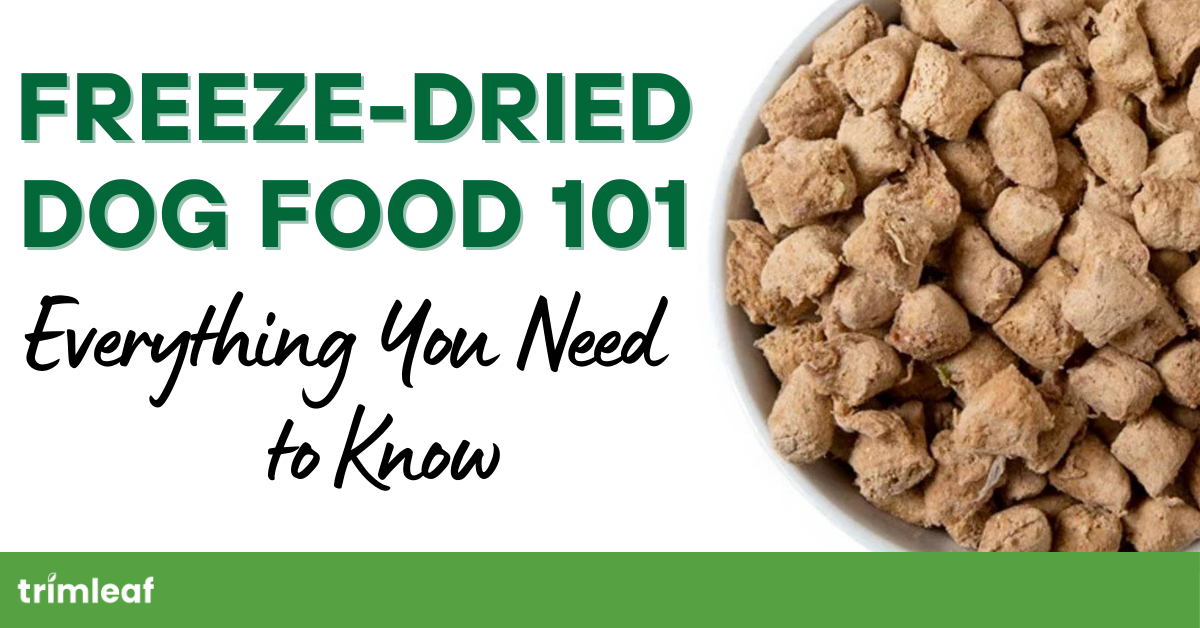
In recent years, freeze-dried food has surged in popularity, grabbing the attention of health-conscious people and convenience seekers.
This innovative food preservation method, once synonymous with astronaut ice cream and survival rations, has now found its way into our daily lives, thanks to the technology becoming more affordable.
Freeze-drying is not only changing the food industry, but also making advancements in the pet food sector.
Amidst the growing demand for high-quality pet nutrition, many pet owners are exploring the advantages of homemade freeze-dried dog food. This approach is a more cost-effective alternative to commercial brands and allows for complete customization to meet specific dietary needs and preferences.
Table of Contents
- What Is Freeze-Dried Dog Food?
- Advantages of Freeze-Dried Dog Food
- Freeze-drying vs. Other Dog Food Preservation Methods
- Possible Disadvantages of Freeze-Dried Dog Food
- Should You Try Freeze Drying Dog Food at Home?
- What Foods Can You Freeze Dry for Dog Food?
- How to Make Homemade Freeze-Dried Dog Food
- Rehydrating the Freeze-Dried Dog Food
- Conclusion
- Frequently Asked Questions About Freeze-Dried Dog Food
What Is Freeze-Dried Dog Food?

Freeze-dried dog food is similar to freeze-dried food eaten by humans. Like its human counterparts, it undergoes a preservation process called lyophilization to remove moisture while retaining the majority of its nutrients.
Freeze drying works by freezing the food at extremely low temperatures. Once frozen, it is placed in a vacuum chamber where the ice is directly converted into vapor through a process known as sublimation.
A gentle amount of heat is applied that is enough to remove the moisture trapped inside the food.
Advantages of Freeze-Dried Dog Food
Looking for a way to fuel your furry friend's health and happiness? Freeze-dried dog food might be the paw-fect solution! It offers a variety of benefits that go beyond just convenience.
Packed with Nutrition
Unlike traditional kibble that uses high heat processing, freeze-drying gently removes moisture while preserving most of the good stuff—vitamins, minerals, proteins, and even some beneficial bacteria.
Happy Tummies, Happy Pups
The gentle drying process in freeze-dried food makes it easier for your dog to digest compared to kibble. This can be a significant change for dogs with sensitive stomachs or allergies.
Convenience at Your Fingertips
Freeze-dried food boasts a long shelf life with no need for refrigeration. It's lightweight and easy to portion out, making it a great option for travel, camping trips, or even just keeping your pantry organized.
Picky Eater Approved
Freeze-dried food's taste and texture are closer to raw meat than kibble, making it more enticing for even the finickiest eaters.
Versatility is Key
Freeze-dried food offers feeding flexibility. You can serve it on its own, rehydrate it with water for a fresher texture, or crumble it as a topper on your dog's regular kibble for an extra nutritional boost.
High in Protein
Freeze-dried dog food is all about high-quality animal protein, offering your pup the building blocks they need for strong muscles, a healthy immune system, and a shiny coat.
Freeze-drying vs. Other Dog Food Preservation Methods

For dog food, freeze-drying is often compared with dehydrating and air-drying for preservation. While fresh ingredients are still the gold standard, preservation is still necessary given the time limitations one may encounter.
- Dehydration removes moisture using warm air but may lead to greater nutrient loss due to the temperature applied.
- Air drying is gentler but still uses high temperatures compared to freeze drying.
- Freeze-drying maintains a raw meat consistency with less nutrient loss due to the gentle heat applied.
Possible Disadvantages of Freeze-Dried Dog Food
While freeze-dried dog food offers numerous benefits, it has some possible disadvantages.
Limited Access
While freeze-dried dog food is becoming more popular, it is not widely available compared to traditional pet foods. This can make it difficult for some pet owners to consistently find their preferred brands.
Cost
Freeze-dried dog food can be more expensive than traditional kibble or canned food. This cost can add up, especially for households with multiple dogs or larger breeds that need more food.
May Cause Upset Stomach
Some dogs may experience digestive upset when transitioning to or consuming freeze-dried food, especially if they have sensitive stomachs or are not used to a raw diet.
Potential Contamination
Despite the preservation process, freeze-dried dog food may still carry bacteria, since it is raw food. It may carry pathogens like Salmonella and Listeria.
That said, freeze-dried dog food, like any other preserved food, should be a supplement, not a replacement, to your pet’s diet. Freshly prepared meals should remain the gold standard.
Should You Try Freeze Drying Dog Food at Home?
If you already have a freeze dryer, making your own meals can be cost-effective in the long run.
What Foods Can You Freeze Dry for Dog Food?

As it is, some foods don’t freeze dry well, due to the possibility of rancidity due to high fat volume. The options also get limited further due to dogs being unable to eat certain foods, and being indigestible or toxic to them.
So what are the best foods to freeze-dry for dog food?
- Cooked organ meats, white and dark meats. Go for lean cuts with a low-fat ratio. You may also freeze dry raw meat.
- Fatty fish like salmon, mackerel, and whitefish are excellent sources of Omega-3 fatty acids.
- Vegetables including carrots, sweet potatoes, green beans, broccoli, cauliflower, and peas.
- Fruits including watermelon, apples, blueberries, bananas, and strawberries.
- Herbs like parsley and turmeric, which are good for dogs.
- Rice, oatmeal, quinoa, and barley.
- Cottage cheese, yogurt, and scrambled or hard-boiled eggs.
How to Make Homemade Freeze-Dried Dog Food

Now that you have an idea about what you can use for dog food, let’s look into how you can turn them into freeze-dried dog food.
The most critical component here is having an appropriate freeze-dryer. This makes the process easier as you only need to use presets here. Other tools you will need include:
- Weighing scale to portion the food into appropriate servings
- Mason jars or mylar bags for storage
- Oxygen absorbers
- Jar sealer for mason jars, or vacuum sealer for mylar bags
The Freeze Drying Process
The freeze-drying process for dogs doesn’t differ from other freeze-drying procedures for freeze drying foods at home.
Step 1
Cut and pre-cook meat and vegetables into equal proportions. Then, evenly spread the food on the trays and freeze them overnight before setting them in the freeze dryer.
Step 2
Transfer the tray into the freeze dryer. Follow your manufacturer's freeze drying time and settings. This process may take up to 24 hours.
Step 3
Check if the freeze-drying process is done. Freeze-dried dog food should feel dry to the touch, and break apart easily. In some cases, the food will look spongy.
Step 4
You can then store them in your containers of choice with oxygen absorbers. Don’t forget to vacuum seal them, and store them in a cool and dry place away from sunlight.
Rehydrating the Freeze-Dried Dog Food

Rehydrating freeze-dried dog food is crucial to ensure your dog gets the necessary moisture and nutrients from their diet. Proper rehydration also makes the food more palatable and easier to digest.
Use warm water to rehydrate freeze-dried food quickly and evenly. You can start with a ratio of one part food and two parts water.
Make sure to mix them thoroughly to ensure water is absorbed. Let it sit for 3 - 5 minutes.
Note:- For raw meats, use clean and filtered water to avoid contaminants. It must look fresh, soft, and moist when rehydrated. Once rehydrated, you must serve it immediately.
- For cooked dog food, you need to ensure it reaches the desired consistency. If the water is too warm or hot, let the food cool before serving.
Conclusion
Freeze-dried dog food combines convenience, nutritional benefits, and long shelf life, making it an increasingly popular choice among pet owners.
Homemade options take the benefits further by allowing pet owners full control over their dog’s diet. Customized recipes to suit specific dietary needs and preferences ensure your dog receives the best nutrition, without spending too much.
But remember, freeze-dried dog food should be a supplement to fresh options, rather than replace them entirely. Always consult with your veterinarian to make informed decisions about your dog’s dietary needs and explore the options available to enhance their overall health and happiness.
For those interested in exploring homemade freeze-dried dog food, investing in a freeze-dryer can be a worthwhile consideration. You can also learn more about freeze-drying food here:
- Is Freeze-Dried Fruit Healthy? What You Need to Know
- What's the Difference Between a Freeze Dryer and a Dehydrator?
- The Best Home Freeze Dryers
- Starting a Freeze-Drying Food Business? Here's What You Need to Know
- Freeze-Dried Peaches: Unlocking Potential and Uses
- How to Freeze Dry Food at Home
Frequently Asked Questions About Freeze-Dried Dog Food
- Should you cook before or after freeze-drying?
-
Some pets and owners go for cooked meals. You have the option to freeze dry the dog food raw or cooked. Which one should you do?
- Cooking before freeze-drying enhances safety and digestibility, making it ideal for reducing bacterial risks and improving nutrient absorption. It is also easier to rehydrate.
- Preparing the meal after freeze-drying retains the raw nutrients, allows for meal customization, and can enhance flavor and texture, making it suitable for those who prefer raw diets and tailored meal preparations.
In the end, what matters is what your pet prefers the more.
- What is freeze-dried dog food?
- Freeze-dried dog food is a type of raw food that undergoes a special drying process. Unlike kibble which uses high heat, freeze-drying gently removes moisture while preserving most of the nutrients, vitamins, minerals, and even some beneficial bacteria found in fresh ingredients.
- Is freeze-dried dog food the same as dehydrated dog food?
- No, freeze-drying and dehydrating are different processes. Freeze-drying removes moisture in a low-pressure, low-temperature environment, while dehydrating uses heat. Freeze-drying generally preserves more nutrients than dehydrating.
- Is freeze-dried dog food safe?
- Commercially produced freeze-dried dog food goes through rigorous safety checks to ensure it's free of harmful bacteria. However, freeze-drying preserves some bacteria, so proper handling is important.
- How long does freeze-dried dog food last?
- Freeze-dried dog food typically has a shelf life of 12-24 months unopened. Once opened, it usually lasts for several weeks in the refrigerator.
- Can puppies eat freeze-dried dog food?
- Consult your veterinarian before introducing freeze-dried food to puppies. Their digestive systems may be more sensitive, and they might require a different kibble size or consistency.
- Can senior dogs eat freeze-dried dog food?
- Freeze-dried food can be a good option for senior dogs, especially those with dental problems or who have difficulty chewing kibble. The softer texture can be easier for them to manage.
- How much freeze-dried dog food should I feed my dog?
- Feeding amounts vary depending on your dog's breed, size, age, and activity level. Always refer to the feeding guidelines on the package and consult your veterinarian for personalized recommendations.
- Is freeze-dried dog food expensive?
- Freeze-dried dog food tends to be more expensive than traditional kibble. However, since it's more concentrated in nutrients, you might need to feed less, potentially offsetting some of the cost.




